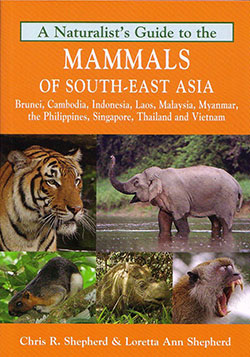(A Naturalist’s Guide to the) Mammals of South-East Asia
By Chris R. Shepherd & Loretta Ann Shepherd – (2012)
 176 pages; matt art paper, with 164 colour photographs, 4 monochrome drawings & 2 maps.
176 pages; matt art paper, with 164 colour photographs, 4 monochrome drawings & 2 maps.
Soft Cover. 18cm x 12.8cm.
ISBN 978-1-906780-71-5
John Beaufoy Publishing Limited UK.
There are approximately 800 species of mammal in South East Asia and this small photographic guide nicely presents 129 of those. This book is a little different to many smaller photographic guide books, as it has a strong message about conservation and the plight of mammals in Asia. Although some of the other smaller books do make mention of conservation, here it is addressed much more logically and seriously, realizing the series levels taking place of man induced abuse and destruction of habitat and fauna everywhere.
Of the species included, each has its common and scientific name with an average measurement of height, head, body and tail length and colour description, global distribution and notes on habits, habitat and other miscellaneous observations and facts. Most of the photos are of a good quality being a mixture of camera trapped, in situ or captivity. Some of them are outstanding in presentation and quality. Of note, 10 of the 11 bat species portrayed are done so brilliantly and a few in flight at close range.
Other highlights include the Philippine Colugo, 4 of the 5 species of Slow Loris are included also excellently photographed, and both the Sumatran and Javan Rhinoceros are included and the recently discovered and also one of the most seriously threatened, the Saola of Vietnam.
There is a checklist at the end of the book of 749 species of (South East Asian) terrestrial based mammals and 32 species of marine mammal, with a key to countries of distribution and conservation status.
Overall this is a rather useful book and nicely illustrated and probably more an instrument of education rather than a field guide. As unless you are out in the jungle and forests actively seeking to observe wildlife, the chances of seeing any of the species included here other than a few squirrels, tree shrews or the odd long tailed macaque, are very remote. However, having said that, instruments of education are imperative and I encourage anything soundly presented such as this book that can bring the plight and wonders of the natural world and the urgency for its conservation to the attention of the broader public and therefore have no hesitation in saying, this book would certainly make a worthy addition to the book shelves of any naturalist or school library.
Rod Rice
Principal Reviewer
Nature & Travel Books
